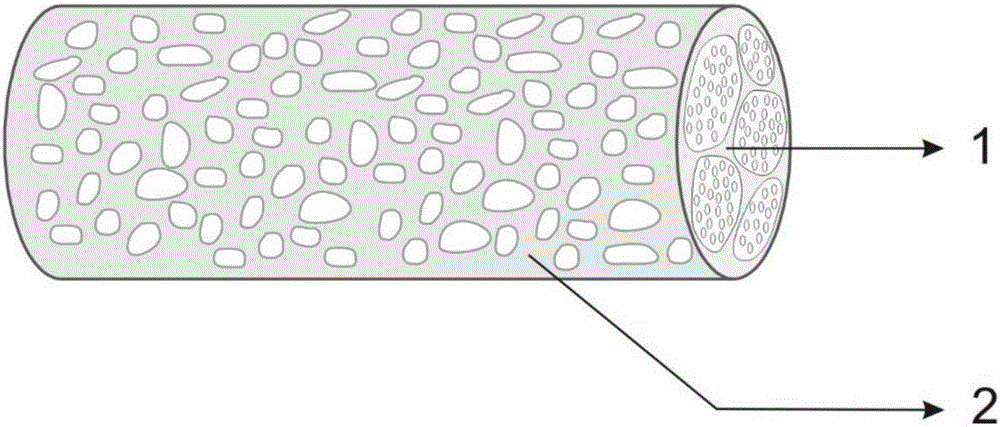Heterologous decellularized nerve graft with tissue adhesion preventing function and preparation method thereof
A nerve transplantation and tissue adhesion technology, applied in tissue regeneration, coating, medical science, etc., can solve problems such as unfavorable nerve connection, scar formation, affecting surgical results, etc., and achieves low cost, tissue adhesion prevention, simple and flexible operation. Effect
- Summary
- Abstract
- Description
- Claims
- Application Information
AI Technical Summary
Problems solved by technology
Method used
Image
Examples
Embodiment 1
[0039] 1. At room temperature, add 2 g of sodium hyaluronate (with a weight average molecular weight of 300,000) into 100 mL of purified water, and stir magnetically for 8 hours until it is completely dissolved to obtain an aqueous solution of sodium hyaluronate with a mass fraction of 2%.
[0040] 2. Immerse the xenogeneic acellular nerve graft as a whole in the above-mentioned sodium hyaluronate aqueous solution for 10 minutes, so that the surface and interior of the acellular nerve are fully infiltrated with the solution.
[0041] 3. The xenogeneic acellular nerve graft impregnated with sodium hyaluronate solution was taken out, pre-frozen at -10°C for 6 hours, and then freeze-dried at -20°C for 10 hours.
[0042] 4. The freeze-dried product is sterilized by cobalt-60 irradiation (irradiation dose is 13KGy), and aseptically packaged to obtain an anti-adhesion xenogeneic acellular nerve graft product containing sodium hyaluronate. The schematic diagram is as follows figure 1...
Embodiment 2
[0045]1. At room temperature, add 1 g of carboxymethyl chitosan (with a weight average molecular weight of 700,000) into 100 mL of purified water, stir magnetically for 4 hours until it dissolves completely, and obtain an aqueous solution of carboxymethyl chitosan with a mass fraction of 1%.
[0046] 2. Immerse the xenogeneic decellularized nerve graft as a whole in the above carboxymethyl chitosan aqueous solution for 20 minutes, so that the surface and interior of the decellularized nerve are fully infiltrated with the solution.
[0047] 3. The heterogeneous decellularized nerve graft impregnated with carboxymethyl chitosan solution was taken out, pre-frozen at -30°C for 3 hours, and then freeze-dried at -15°C for 6 hours.
[0048] 4. The freeze-dried product is sterilized with ethylene oxide, and aseptically packaged to obtain an anti-adhesion heterogeneous acellular nerve graft containing carboxymethyl chitosan, the schematic diagram of which is shown in figure 1 shown.
...
Embodiment 3
[0051] 1. At room temperature, add 1.5 g of carboxymethyl cellulose (with a weight average molecular weight of 500,000) into 100 mL of purified water, and magnetically stir for 6 hours until it is completely dissolved to obtain a carboxymethyl cellulose aqueous solution with a mass fraction of 1.5%.
[0052] 2. Immerse the xenogeneic decellularized nerve graft as a whole in the above carboxymethyl cellulose aqueous solution for 15 minutes, so that the surface and interior of the decellularized nerve are fully infiltrated with the solution.
[0053] 3. The xenogeneic acellular nerve graft impregnated with carboxymethyl cellulose solution was taken out, pre-frozen at -20°C for 4 hours, and then freeze-dried at -10°C for 6 hours.
[0054] 4. The freeze-dried product is sterilized by electron beam irradiation (irradiation dose is 15KGy), and aseptically packaged to obtain an anti-adhesion heterogeneous decellularized nerve graft product containing carboxymethyl cellulose. The schem...
PUM
| Property | Measurement | Unit |
|---|---|---|
| thickness | aaaaa | aaaaa |
| molecular weight | aaaaa | aaaaa |
| thickness | aaaaa | aaaaa |
Abstract
Description
Claims
Application Information
 Login to View More
Login to View More - R&D
- Intellectual Property
- Life Sciences
- Materials
- Tech Scout
- Unparalleled Data Quality
- Higher Quality Content
- 60% Fewer Hallucinations
Browse by: Latest US Patents, China's latest patents, Technical Efficacy Thesaurus, Application Domain, Technology Topic, Popular Technical Reports.
© 2025 PatSnap. All rights reserved.Legal|Privacy policy|Modern Slavery Act Transparency Statement|Sitemap|About US| Contact US: help@patsnap.com

